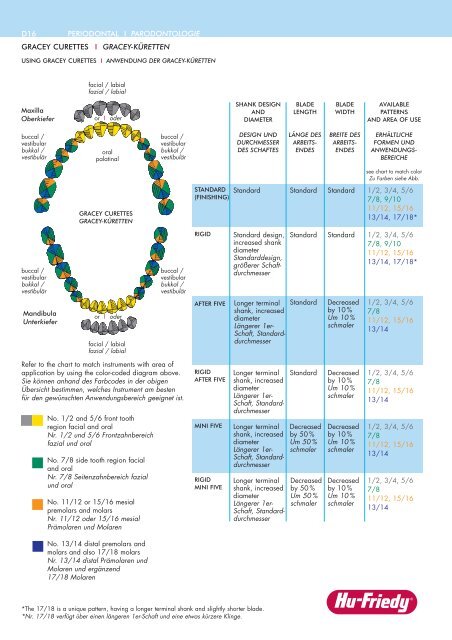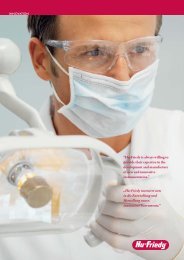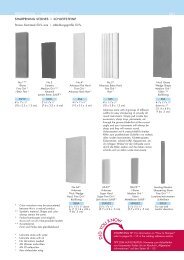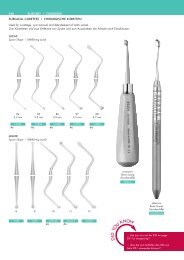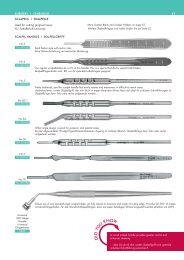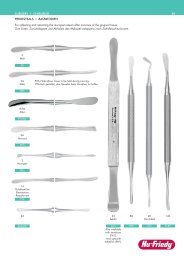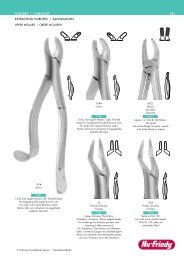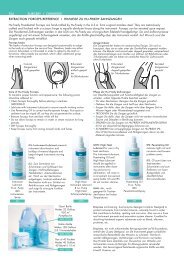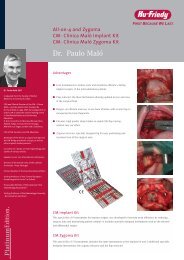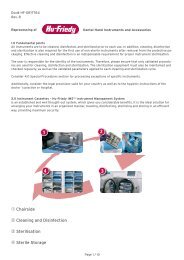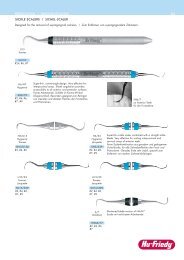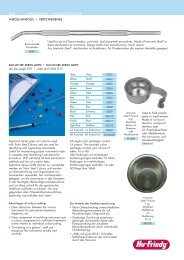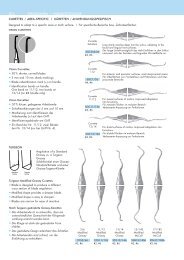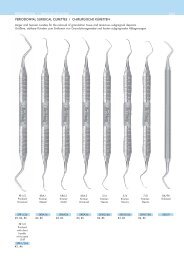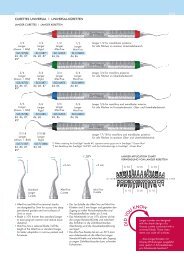Anwendung der Gracey Kürette - Hu-Friedy
Anwendung der Gracey Kürette - Hu-Friedy
Anwendung der Gracey Kürette - Hu-Friedy
Sie wollen auch ein ePaper? Erhöhen Sie die Reichweite Ihrer Titel.
YUMPU macht aus Druck-PDFs automatisch weboptimierte ePaper, die Google liebt.
D16 PERIODONTAL I PARODONTOLOGIE<br />
GRACEY CURETTES I GRACEY-KÜRETTEN<br />
USING GRACEY CURETTES I ANWENDUNG DER GRACEY-KÜRETTEN<br />
facial / labial<br />
fazial / labial<br />
Maxilla<br />
Oberkiefer<br />
or I o<strong>der</strong><br />
SHANK DESIGN<br />
AND<br />
DIAMETER<br />
BLADE<br />
LENGTH<br />
BLADE<br />
WIDTH<br />
AVAILABLE<br />
PATTERNS<br />
AND AREA OF USE<br />
buccal /<br />
vestibular<br />
bukkal /<br />
vestibulär<br />
oral<br />
palatinal<br />
buccal /<br />
vestibular<br />
bukkal /<br />
vestibulär<br />
DESIGN UND<br />
DURCHMESSER<br />
DES SCHAFTES<br />
LÄNGE DES<br />
ARBEITS -<br />
ENDES<br />
BREITE DES<br />
ARBEITS -<br />
ENDES<br />
ERHÄLTLICHE<br />
FORMEN UND<br />
ANWENDUNGS -<br />
BEREICHE<br />
see chart to match color<br />
Zu Farben siehe Abb.<br />
GRACEY CURETTES<br />
GRACEY-KÜRETTEN<br />
STANDARD<br />
(FINISHING)<br />
Standard<br />
Standard<br />
Standard<br />
1/2, 3/4, 5/6<br />
7/8, 9/10<br />
11/12, 15/16<br />
13/14, 17/18*<br />
buccal /<br />
vestibular<br />
bukkal /<br />
vestibulär<br />
buccal /<br />
vestibular<br />
bukkal /<br />
vestibulär<br />
RIGID<br />
Standard design,<br />
increased shank<br />
diameter<br />
Standard design,<br />
größerer Schaft -<br />
durchmesser<br />
Standard<br />
Standard<br />
1/2, 3/4, 5/6<br />
7/8, 9/10<br />
11/12, 15/16<br />
13/14, 17/18*<br />
Mandibula<br />
Unterkiefer<br />
or I o<strong>der</strong><br />
facial / labial<br />
fazial / labial<br />
AFTER FIVE<br />
Longer terminal<br />
shank, increased<br />
diameter<br />
Längerer 1er-<br />
Schaft, Standard -<br />
durch messer<br />
Standard<br />
Decreased<br />
by 10 %<br />
Um 10 %<br />
schmaler<br />
1/2, 3/4, 5/6<br />
7/8<br />
11/12, 15/16<br />
13/14<br />
Refer to the chart to match instruments with area of<br />
application by using the color-coded diagram above.<br />
Sie können anhand des Farbcodes in <strong>der</strong> obigen<br />
Übersicht bestimmen, welches Instrument am besten<br />
für den gewünschten <strong>Anwendung</strong>sbereich geeignet ist.<br />
No. 1/2 and 5/6 front tooth<br />
region facial and oral<br />
Nr. 1/2 und 5/6 Frontzahnbereich<br />
fazial und oral<br />
No. 7/8 side tooth region facial<br />
and oral<br />
Nr. 7/8 Seitenzahnbereich fazial<br />
und oral<br />
No. 11/12 or 15/16 mesial<br />
premolars and molars<br />
Nr. 11/12 o<strong>der</strong> 15/16 mesial<br />
Prämolaren und Molaren<br />
RIGID<br />
AFTER FIVE<br />
Longer terminal<br />
shank, increased<br />
diameter<br />
Längerer 1er-<br />
Schaft, Standarddurch<br />
messer<br />
Longer terminal<br />
shank, increased<br />
diameter<br />
Längerer 1er-<br />
Schaft, Standarddurch<br />
messer<br />
Standard<br />
Decreased<br />
by 10 %<br />
Um 10 %<br />
schmaler<br />
1/2, 3/4, 5/6<br />
7/8<br />
11/12, 15/16<br />
13/14<br />
MINI FIVE Longer terminal Decreased Decreased 1/2, 3/4, 5/6<br />
shank, increased by 50 % by 10 % 7/8<br />
diameter Um 50 % Um 10 % 11/12, 15/16<br />
Längerer 1er- schmaler schmaler<br />
13/14<br />
Schaft, Standarddurch<br />
messer<br />
RIGID<br />
MINI FIVE<br />
Decreased<br />
by 50 %<br />
Um 50 %<br />
schmaler<br />
Decreased<br />
by 10 %<br />
Um 10 %<br />
schmaler<br />
1/2, 3/4, 5/6<br />
7/8<br />
11/12, 15/16<br />
13/14<br />
No. 13/14 distal premolars and<br />
molars and also 17/18 molars<br />
Nr. 13/14 distal Prämolaren und<br />
Molaren und ergänzend<br />
17/18 Molaren<br />
*The 17/18 is a unique pattern, having a longer terminal shank and slightly shorter blade.<br />
*Nr. 17/18 verfügt über einen längeren 1er-Schaft und eine etwas kürzere Klinge.
PERIODONTAL I PARODONTOLOGIE<br />
GRACEY CURETTES<br />
I GRACEY-KÜRETTEN<br />
D17<br />
3<br />
distal<br />
6<br />
facial / buccal<br />
(maxilla and<br />
mandibula)<br />
fazial / bukkal<br />
(Ober- und<br />
Unterkiefer)<br />
1 4<br />
lingual / oral<br />
(mandibula)<br />
palatal (maxilla)<br />
lingual oral<br />
(Unterkiefer)<br />
palatinal<br />
(Oberkiefer)<br />
2<br />
mesial<br />
5<br />
Systematic cleaning: “surface-by-surface”<br />
• The cleaning procedure should overlap surfaces.<br />
• The numbers given above show the sequence of a systematic cleaning procedure.<br />
• The arrows show the direction in wich the instrument tip points during cleaning.<br />
Systematisch reinigen: „Fläche-um-Fläche“<br />
• Der Reinigungsvorgang sollte flächenüberlappend sein.<br />
• Die o.g. Nummern zeigen die Reihenfolge des systematischen Reinigungsvorganges.<br />
• Die Pfeile geben die Richtung an, in welche die Instrumentenspitze während <strong>der</strong> Reinigung zeigt.<br />
You can change the look of<br />
your Satin Steel Colors or<br />
EverEdge ® instruments at any<br />
time.<br />
Just follow the directions to<br />
change the instrument to<br />
your favorite color. Your new<br />
instrument set will be ready<br />
for use in just a few minutes<br />
(see page D10).<br />
Sie haben je<strong>der</strong>zeit die<br />
Möglichkeit, das Aussehen<br />
Ihres Satin Steel Colourso<strong>der</strong><br />
EverEdge ® -Instruments<br />
zu verän<strong>der</strong>n.<br />
Um das Instrument Ihrer<br />
Wunschfarbe anzupassen,<br />
folgen Sie einfach den<br />
neben gezeigten Schritten.<br />
Innerhalb weniger Minuten<br />
haben Sie Ihr neues Instrumentarium<br />
optimal einsatzbereit<br />
(siehe Seite D10).
D18<br />
GRACEY CURETTES<br />
Blade angulation<br />
of a <strong>Gracey</strong><br />
Curette<br />
Winkel zwischen<br />
1er-Schaft und<br />
Fazialfläche einer<br />
<strong>Gracey</strong>-Kürette<br />
I GRACEY-KÜRETTEN<br />
Designed to adapt to a specific area or tooth surface. I Für spezifische Bereiche.<br />
face<br />
toe<br />
back<br />
70°<br />
cutting edge<br />
lateral surface<br />
PERIODONTAL I PARODONTOLOGIE<br />
SG1/2 Anterior<br />
SG1/2 Frontzahnbereich<br />
<strong>Gracey</strong> Standard Curettes<br />
• Area-specific to allow for deep<br />
scaling, root planing and perio -<br />
dontal debridement.<br />
• Offset blade provides a perfect<br />
working angulation for the<br />
tooth surface.<br />
• Offset blade angulation means<br />
only the lower cutting edge of<br />
each blade is used.<br />
Posterior SG7/8<br />
SG7/8 für den molaren und prämolaren<br />
Bereich, oral und fazial.<br />
<strong>Gracey</strong>-Küretten<br />
• Speziell zum deep scaling und zum<br />
Wurzelglätten.<br />
• Bei Spezial-Küretten liegt <strong>der</strong> 1er-Schaft (<strong>der</strong><br />
dem Arbeitsende am nächsten liegt) und die<br />
Fazialfläche im 70 °-Winkel. Beim Entfernen<br />
von Ablagerungen an Zahn- bzw. Wurzeloberflächen<br />
sollte <strong>der</strong> 1er-Schaft so gut wie<br />
möglich parallel zu <strong>der</strong> Fläche gebracht<br />
werden, die bearbeitet wird.<br />
• Diese Kürette hat eine konkave und eine<br />
konvexe Kante. Die konvexe Kante ist die<br />
Schneidekante, sie liegt beim Arbeitsvorgang<br />
tiefer.<br />
GRACEY STANDARD CURETTES I GRACEY-STANDARD-KÜRETTEN (erhältlich auch in „R“ rigid Ausführung mit starrem Schaft)<br />
1/2<br />
(shown I Bild)<br />
SG1/291<br />
1/2<br />
1/2<br />
Rigid<br />
SG1/26 SG1/2R9<br />
#2, #6 #6, #7, #9<br />
Slight contra-angle for anterior incisors<br />
and canines.<br />
Leicht abgewinkelt für Frontzähne.<br />
3/4<br />
(shown I Bild)<br />
SG3/499<br />
3/4<br />
SG3/49<br />
#2, #4, #6,<br />
#7, #9<br />
3/4<br />
Rigid<br />
SG3/4R9<br />
#6, #7, #9<br />
Medium contra-angle for anteriors and<br />
premolars.<br />
Stärker abgewinkelt für die Frontzähne<br />
und die Prämolaren.<br />
5/6*<br />
(shown I Bild)<br />
SG5/695<br />
5/6<br />
5/6<br />
Rigid<br />
5/6<br />
Extra Rigid<br />
SG5/66 SG5/6R9 SG5/6ER7<br />
#2, #6 #6, #7, #9 #4, #6, #7<br />
Short contra-angle for anterior incisors<br />
and canines.<br />
Leicht abgewinkelt für die Frontzähne<br />
und die Prämolaren.<br />
7/8*<br />
(shown I Bild)<br />
SG7/897<br />
7/8<br />
7/8<br />
Rigid<br />
SG7/86 SG7/8R9<br />
#2, #6 #6, #7, #9<br />
7/8<br />
Extra Rigid<br />
SG7/8ER7<br />
#4, #6, #7<br />
Medium contra-angle for premolars and<br />
molars, facial and lingual surfaces.<br />
Stärker abgewinkelt für die Prämolaren,<br />
Molaren, faziale und orale Flächen.<br />
NOTE: Area-specific curettes also available<br />
in Kramer-Nevins and Turgeon designs.<br />
HINWEIS: Die bereichsspezifischen Küretten<br />
sind ebenfalls als Kramer-Nevins- und<br />
Turgeon-Ausführungen erhältlich.<br />
DID<br />
YOU KNOW<br />
Extra Rigid <strong>Gracey</strong> curettes are ideal for tenacious calculus removal, gross scaling, and<br />
initial debridement. Blades, however, are identical in size to standard <strong>Gracey</strong> curettes.<br />
Extrastarre <strong>Gracey</strong>-Küretten sind ideal geeignet zum Entfernen von hartnäckigem<br />
Zahnstein, für die Grobreinigung und zum ersten Entfernen von Ablagerungen.<br />
Die Arbeitsenden entsprechen denen <strong>der</strong> <strong>Gracey</strong>-Standard-Küretten.
PERIODONTAL I PARODONTOLOGIE<br />
GRACEY CURETTES<br />
I GRACEY-KÜRETTEN<br />
D19<br />
SG11/12<br />
Posterior<br />
Für den mesialen Bereich<br />
SG13/14<br />
Posterior<br />
Für den distalen Bereich<br />
SG15/16<br />
Posterior<br />
Für den mesialen Bereich<br />
SG17/18<br />
Posterior<br />
Für den distalen Bereich<br />
9/10<br />
(shown I Bild)<br />
SG9/1096<br />
9/10<br />
SG9/106<br />
#2, #6<br />
9/10<br />
Rigid<br />
SG9/10R7<br />
#4, #6, #7<br />
Long contra-angle for molar buccal and lingual<br />
surfaces. More pronounced angle than 7/8 for<br />
less accessible root surfaces.<br />
Langer, stark abgewinkelter 1er-Schaft, für alle<br />
oralen und fazialen Flächen <strong>der</strong> Molaren und<br />
Prämolaren, durch die starke Abwinkelung wird<br />
<strong>der</strong> Zugang bei geringer Mundöffnung erleichtert.<br />
11/12<br />
(shown I Bild)<br />
SG11/1293<br />
11/12<br />
11/12<br />
Rigid<br />
SG11/126 SG11/12R9<br />
#2, #6 #6, #7, #9<br />
11/12<br />
Extra Rigid<br />
SG11/12ER7<br />
#4, #6, #7<br />
Angulated to reach mesial surfaces of<br />
posterior teeth.<br />
Abgewinkelt für die mesialen Flächen im<br />
molaren und prämolaren Bereich.<br />
13/14*<br />
(shown I Bild)<br />
SG13/1498<br />
13/14<br />
13/14<br />
Rigid<br />
SG13/146 SG13/14R9<br />
#2, #6 #6, #7, #9<br />
13/14<br />
Extra Rigid<br />
SG13/14ER7<br />
#4, #6, #7<br />
Angulated to reach distal surfaces of<br />
posterior teeth.<br />
Stark abgewinkelt für die distalen Flächen im<br />
molaren und prämolaren Bereich.<br />
15/16*<br />
(shown I Bild)<br />
SG15/1693<br />
15/16<br />
15/16<br />
Rigid<br />
SG15/166 SG15/16R9<br />
#2, #6 #6, #7, #9<br />
Same shank bends as 13/14, but blade positioned<br />
to reach mesial posterior surfaces.<br />
Stark abgewinkelt wie 13/14-Schneide, aber<br />
gegen sätzlich für die mesialen Flächen im<br />
molaren und prä molaren Bereich. Speziell bei<br />
verlagerten Zähnen und kleiner Mundöffnung<br />
wird <strong>der</strong> Zugang erleichtert.<br />
17/18*<br />
(shown I Bild)<br />
SG17/1898<br />
17/18<br />
17/18<br />
Rigid<br />
SG17/186 SG17/18R9<br />
#2, #6 #6, #7, #9<br />
Accentuated angles improve access to distal<br />
posterior surfaces. Also has smaller blade and<br />
slightly longer terminal shank.<br />
Stärker gewinkelt, dadurch erweiterter Einsatz<br />
für distale und posteriore Flächen sowie tiefe<br />
Zahnfleischtaschen.<br />
DID<br />
YOU KNOW<br />
The Rigid <strong>Gracey</strong> has a thicker, stronger, and less flexible shank than the standard <strong>Gracey</strong>. This allows for<br />
mo<strong>der</strong>ate to heavy calculus removal without having to utilize additional heavy scalers such as sickles and hoes.<br />
... dass <strong>Gracey</strong>-Küretten rigide (starre Ausführung) mit einem stärkeren und weniger flexiblen Schaft ausgestattet<br />
sind als die <strong>Gracey</strong>-Standard-Küretten? Küretten in starrer Ausführung werden zum Entfernen von<br />
stärkeren Ablagerungen verwendet.
D20 PERIODONTAL I PARODONTOLOGIE<br />
GRACEY CURETTES I GRACEY-KÜRETTEN<br />
211/212<br />
<strong>Gracey</strong><br />
SG211/1273<br />
#2, #4, #6, #7<br />
Angled for the mesial surfaces in the molar and premolar area.<br />
Abgewinkelt für die mesialen Flächen im molaren und<br />
prämolaren Bereich.<br />
211/212M<br />
<strong>Gracey</strong><br />
SG211/2M73<br />
#2, #4, #6, #7<br />
Angled for the mesial surfaces in the molar and premolar area.<br />
Mini-version.<br />
Abgewinkelt für die mesialen Flächen im molaren und<br />
prämolaren Bereich. Mini-Ausführung.<br />
213/214<br />
<strong>Gracey</strong><br />
SG213/1478<br />
#2, #4, #6, #7<br />
Sharply angled for the distal surfaces in the molar and<br />
premolar area.<br />
Stark abgewinkelt für die distalen Flächen im molaren und<br />
prämolaren Bereich.<br />
213/214M<br />
<strong>Gracey</strong><br />
SG213/4M78<br />
#2, #4, #6, #7<br />
Sharply angled for the distal surfaces in the moral and<br />
premolar area. Mini-version.<br />
Stark abgewinkelt für die distalen Flächen im molaren und<br />
prämolaren Bereich. Mini-Ausführung.<br />
215/216<br />
<strong>Gracey</strong><br />
SG215/1675<br />
#2, #4, #6, #7<br />
Sharply angled like 13/14, but in the opposite way for the<br />
mesial surfaces in the molar and premolar area.<br />
Stark abgewinkelt wie 13/14, jedoch gegensätzlich für die<br />
mesialen Flächen im molaren und prämolaren Bereich.<br />
215/216M<br />
<strong>Gracey</strong><br />
SG215/6M75<br />
#2, #4, #6, #7<br />
Sharply angled like 13/14, but in the opposite way for<br />
the mesial surfaces in the molar and premolar area.<br />
Mini-version.<br />
Stark abgewinkelt wie 13/14, jedoch gegensätzlich für<br />
die mesialen Flächen im molaren und prämolaren<br />
Bereich. Mini-Ausführung.<br />
The Clayton <strong>Gracey</strong> Story<br />
In the late 1940s an innovative dentist from the University of Michigan had a vision. Clayton <strong>Gracey</strong> wanted to “give every dentist the possi bility to<br />
treat even the deepest and least accessible periodontal pockets simply and without traumatic stretching of the gingiva.” Dr. <strong>Gracey</strong> brought his idea<br />
to <strong>Hu</strong>go Friedman, the foun<strong>der</strong> of <strong>Hu</strong>-<strong>Friedy</strong>, who supported his concept. Together they developed a series of 14 single-ended area-specific<br />
instruments for the successful removal of deposits from root surfaces. Dr. <strong>Gracey</strong>’s designs laid the groundwork for the new instruments of today.<br />
Currently, <strong>Gracey</strong> curettes are available as double-ended instruments with multiple handle choices.<br />
The <strong>Gracey</strong> curettes have come a long way since the original design. <strong>Hu</strong>-<strong>Friedy</strong> currently manufactures a variety of styles and patterns, such as<br />
After Five curettes with a longer terminal shank and thinned blade, Mini Five curettes with After Five features and a shorter blade, and the new<br />
15/16 and 17/18 patterns. An optional Rigid shank is available on all of the <strong>Gracey</strong> designs. <strong>Hu</strong>-<strong>Friedy</strong> is continually looking for new ways to<br />
improve our existing products. Our success is dedicated to the pioneers in dentistry, including Dr. Clayton <strong>Gracey</strong>, who helped make a vision<br />
become a reality and a part of every dental office today.
PERIODONTAL I PARODONTOLOGIE<br />
GRACEY CURETTES<br />
I GRACEY-KÜRETTEN<br />
D21<br />
Designed to adapt to a specific area or tooth surface. I Für spezifische Bereiche bzw. Zahnoberflächen.<br />
GRACEY MESIAL-DISTAL CURETTES<br />
GRACEY-MESIAL / DISTAL-KÜRETTEN<br />
These combinations of working ends are designed to<br />
complete an entire facial or lingual sextant without<br />
changing instruments, increasing efficiency.<br />
Mesial/Distal-Küretten für die molaren und prämolaren<br />
Bereiche. Diese zeitsparenden Instrumente sind so konzipiert,<br />
dass mit einem Ende z.B. alle rechten mesialen<br />
Flächen (vom Patienten aus gesehen), mit dem an<strong>der</strong>en<br />
Ende alle rechten distalen Flächen gereinigt werden<br />
können. Für die linken Seiten wird dementsprechend das<br />
zweite Instrument eingesetzt. Diese Kombinationen<br />
ersparen einen zusätzlichen Griff in das Tray und<br />
unnötiges Suchen nach den korrekten Arbeitsenden.<br />
GRACEY PROPHY CURETTES<br />
GRACEY-SPEZIAL-PROPHYLAXE-KÜRETTEN<br />
The blades are the same size as the <strong>Gracey</strong> Standard<br />
Curettes, but the shank is shorter and more rigid for removal<br />
of supra-gingival deposits.<br />
Arbeitsenden in <strong>der</strong>selben Größe wie bei den <strong>Gracey</strong>-<br />
Finishing-Küretten, aber mit kürzerem Schaft und in starrer<br />
Ausführung zum Entfernen supra gingivaler Ablagerungen.<br />
Dieser Satz besteht aus vier doppelendigen Instrumenten.<br />
P1/2*<br />
SGP1/27<br />
#2, #7<br />
11/14<br />
Mesial / Distal<br />
(shown I Bild)<br />
SG11/149<br />
#2, #4, #6,<br />
#7, #9<br />
11/14<br />
Mesial / Distal<br />
Rigid<br />
SGR11/14R<br />
#2, #4<br />
P3/4*<br />
SGP3/47<br />
#2, #7<br />
12/13<br />
Mesial / Distal<br />
(shown I Bild)<br />
SG12/139<br />
#2, #4, #6,<br />
#7, #9<br />
P5/6*<br />
SGP5/67<br />
#2, #7<br />
P7/8*<br />
SGP7/87<br />
#2, #7<br />
266/267<br />
S266/679<br />
#7<br />
*) These numbers 1/2, 3/4 etc.) do not<br />
corres pond with the numbers of the<br />
<strong>Gracey</strong> curettes.<br />
*) Diese Nummern (1/2, 3/4 usw.) sind<br />
nicht identisch mit den <strong>Gracey</strong>-<br />
Küretten-Nummern.<br />
Die ersten GRACEY-Küretten wurden von <strong>Hu</strong>-<strong>Friedy</strong> produziert !<br />
Schon in den 30er Jahren erkannte Dr. Clayton H. <strong>Gracey</strong> die Notwendigkeit für bereichsspezifische Küretten. Die ihm seiner zeit zur Verfügung<br />
stehenden Universal-Küretten konnten zwar an allen Zahnoberflächen benutzt werden, aber ihre Anpassungsfähigkeit war bei <strong>der</strong> Behandlung von<br />
Patienten mit tiefen Zahnfleischtaschen, konvexen Wurzel ober flächen und an<strong>der</strong>en morpholo gischen Unregelmäßig keiten doch sehr eingeschränkt.<br />
Dieses Problem <strong>der</strong> mangelnden Anpassungs fähigkeit in vielen subgingivalen Bereichen veranlaßte Dr. <strong>Gracey</strong> mit einem ortsansässigen Schmied in<br />
Ann Arbor, Michigan, zusam menzuarbeiten und das Modell einer Spezial-Kürette zu erstellen. In den 40er Jahren entwickelte Dr. <strong>Gracey</strong> dann<br />
zusammen mit <strong>Hu</strong>go Friedmann, <strong>der</strong> im Jahr 1908 die Firma HU-FRIEDY gegründet hatte, den nach ihm benannten bereichsspezifischen <strong>Gracey</strong>-<br />
Küretten-Satz. Der Original HU-FRIEDY-<strong>Gracey</strong>-Satz besteht aus 14 einendigen o<strong>der</strong> 7 doppel endigen Instrumenten. Zunächst waren die Original<br />
Instrumente so konzipiert, dass sie mit einem „PUSH-STROKE“ (mit einer Schiebebewegung) benutzt werden mußten und Konkremente in die<br />
Zahnfleischtaschen geschoben wurden. Viele von Dr. <strong>Gracey</strong>s Kollegen waren mit dieser Ausführung nicht einverstanden. Aus diesem Grunde modifizierte<br />
er die <strong>Gracey</strong>-Küretten in „PULL-STROKE-Küretten“ (in Ziehküretten), mit denen die Konkremente aus <strong>der</strong> Zahnfleischtasche gezogen werden.<br />
Diese HU-FRIEDY-<strong>Gracey</strong>-Küretten sind auch heute noch die weltweit von Klinikern am häufigsten benützten Küretten und genießen hohes Ansehen.
D22<br />
GRACEY CURETTES<br />
3 mm<br />
PERIODONTAL I PARODONTOLOGIE<br />
I GRACEY-KÜRETTEN<br />
Designed to adapt to a specific area or tooth surface. I Für spezifische Bereiche bzw. Zahnoberflächen.<br />
Terminal shank redesigned<br />
to be 3 mm longer than a<br />
standard <strong>Gracey</strong> curette.<br />
1er-Schaft 3 mm länger als<br />
bei den Standard-<strong>Gracey</strong>-<br />
Küretten.<br />
<strong>Gracey</strong> After Five curette<br />
reaching deep into a<br />
pocket.<br />
Die After-Five Kürette für<br />
Zahn fleisch taschen, die<br />
tiefer als 5 mm liegen.<br />
After Five Curettes<br />
After-Five Küretten<br />
• Terminal shank elongated by<br />
3 mm for access into deep<br />
periodontal pockets and root<br />
surfaces of 5mm or more and<br />
better clearance around the<br />
crown.<br />
• Blade thinned by 10 % to ease<br />
gingival insertion and reduce<br />
tissue distention.<br />
• Area-specific design patterned<br />
after the standard <strong>Gracey</strong>s offers<br />
exact adaptation and control.<br />
• Available in Rigid and Extra<br />
Rigid designs for greater strength<br />
when needed.<br />
• 1er-Schaft 3 mm länger für tiefe<br />
Parodontaltaschen (mind. 5 mm).<br />
• Schmales Arbeitsende erleichtert<br />
das Einführen in die Zahnfleischtaschen,<br />
reduziert die Gewebeüberdehnung.<br />
• Hergestellt nach den Originalplänen<br />
von Dr. <strong>Gracey</strong>.<br />
AFTER FIVE<br />
MESIAL / DISTAL<br />
1/2<br />
grey I grau<br />
SRPG1/291<br />
#2, #4, #6,<br />
#7, #9<br />
3/4<br />
SRPG3/49<br />
#2, #4, #6,<br />
#7, #9<br />
5/6<br />
yellow I gelb<br />
SRPG5/695<br />
#2, #4, #6,<br />
#7, #9<br />
7/8<br />
green I grün<br />
SRPG7/897<br />
#2, #4, #6,<br />
#7, #9<br />
11/12<br />
orange<br />
SRP11/1293<br />
#2, #4, #6,<br />
#7, #9<br />
13/14<br />
blue I blau<br />
SRP13/1498<br />
#2, #4, #6,<br />
#7, #9<br />
15/16<br />
orange<br />
SRP15/1693<br />
#2, #4, #6,<br />
#7, #9<br />
11/14<br />
Mesial / Distal<br />
blue / orange<br />
blau / orange<br />
12/13<br />
Mesial / Distal<br />
orange / blue<br />
orange / blau<br />
Rigid<br />
Rigid<br />
Rigid<br />
Rigid<br />
Rigid<br />
Rigid<br />
Rigid<br />
Rigid<br />
Rigid<br />
SRP1/2R9<br />
#2, #4, #6,<br />
#7, #9<br />
SRP3/4R9<br />
#2, #6, #7,<br />
#9<br />
SRP5/6R9<br />
#2, #4, #6,<br />
#7, #9<br />
SRP7/8R9<br />
#2, #6, #7,<br />
#9<br />
SRP11/12R9<br />
#2, #4, #6,<br />
#7, #9<br />
SRP13/14R9<br />
#2, #4, #6,<br />
#7, #9<br />
SRP15/16R9<br />
#2, #4, #6,<br />
#7, #9<br />
SRP11/14R4 SRP12/13R4<br />
#4 #4<br />
Extra Rigid Extra Rigid<br />
SRP5/6E7 SRP7/8E7<br />
#6, #7 #6, #7<br />
Extra Rigid<br />
SRP11/12E7<br />
#6, #7<br />
Extra Rigid<br />
SRP13/14E7<br />
#6, #7
PERIODONTAL I PARODONTOLOGIE<br />
GRACEY CURETTES<br />
I GRACEY-KÜRETTEN<br />
D23<br />
Designed to adapt to a specific area or tooth surface. I Für spezifische Bereiche bzw. Zahnoberflächen.<br />
•——•<br />
•————•<br />
Standard<br />
<strong>Gracey</strong> Curette<br />
•——•<br />
After Five<br />
Curette<br />
Mini Five reaching<br />
into a deep pocket<br />
on a narrow root.<br />
Die Mini-Five Küretten<br />
für tiefe Zahnfleisch -<br />
taschen und schmalen<br />
Wurzeldurchmesser.<br />
•——————•<br />
+3 mm<br />
./. 50 %<br />
•—•<br />
•——————•<br />
Mini Five<br />
Curette<br />
+3 mm<br />
Mini Five Curettes<br />
• Terminal shank elongated by<br />
3 mm for access into deep<br />
periodontal pockets and root<br />
surfaces of 5 mm or more.<br />
• Reduced blade, half the length of<br />
the After Five or standard<br />
<strong>Gracey</strong>, for better adaptation in<br />
narrow pockets and furcations.<br />
• Blade is 10 % thinner than<br />
standard <strong>Gracey</strong> to ease<br />
gingival insertion and reduce<br />
tissue distention.<br />
• Area-specific design patterned<br />
after the standard <strong>Gracey</strong>s offers<br />
exact adaptation and control.<br />
• Available in Rigid designs for<br />
greater strength when needed.<br />
Mini-Five Küretten<br />
• Besserer Zugang in tiefe Zahnfleisch<br />
taschen (tiefer als 5 mm)<br />
durch den um 3 mm verlängerten<br />
1er-Schaft.<br />
• Kürzeres Arbeitsende als die<br />
After-Five-Kürette, erleichtert den<br />
Zugang zu schmalen Wurzel -<br />
oberflächen.<br />
• Schmales Arbeitsende, vermin<strong>der</strong>t<br />
beim Einführen des Instrumentes<br />
die Dehnung des gingivalen<br />
Gewebes – folglich<br />
weniger Trauma.<br />
• Exzellenter Zugang zu allen<br />
Wurzel oberflächen, hervorragend<br />
für den Frontzahnbereich,<br />
minimiertes Risiko<br />
einer Gewebeverletzung.<br />
• Auch in starrer („rigid“)<br />
Ausführung erhältlich.<br />
MINI FIVE<br />
MESIAL / DISTAL<br />
1/2<br />
grey I grau<br />
SAS1/291<br />
#2, #4, #6,<br />
#7, #9<br />
Rigid<br />
3/4<br />
SAS3/49<br />
#2, #4, #6,<br />
#7, #9<br />
Rigid<br />
5/6 7/8<br />
yellow I gelb green I grün<br />
SAS5/695<br />
#2, #4, #6,<br />
#7, #9<br />
Rigid<br />
SAS7/897<br />
#2, #4, #6,<br />
#7, #9<br />
Rigid<br />
11/12<br />
orange<br />
Rigid<br />
13/14<br />
blue I blau<br />
Rigid<br />
15/16<br />
orange<br />
SAS11/1293 SAS13/1498 SAS15/1693<br />
#2, #4, #6, #2, #4, #6, #2, #4, #6,<br />
#7, #9 #7, #9 #7, #9<br />
Rigid<br />
17/18<br />
blue I blau<br />
SAS17/1898<br />
#7, #9<br />
11/14<br />
Mesial /<br />
Distal<br />
SAS11/147<br />
#2, #4, #6,<br />
#7, #9<br />
Rigid<br />
12/13<br />
Mesial /<br />
Distal<br />
SAS12/137<br />
#2, #4, #6,<br />
#7, #9<br />
SAS1/2R9<br />
#2, #4, #6,<br />
#7, #9<br />
SAS3/4R9<br />
#2, #4, #6,<br />
#7, #9<br />
SAS5/6R9<br />
#2, #4, #6,<br />
#7, #9<br />
SAS7/8R9<br />
#2, #4, #6,<br />
#7, #9<br />
SAS11/12R9 SAS13/14R9 SAS15/16R9<br />
#2, #4, #6, #2, #4, #6, #2, #4, #6,<br />
#7, #9 #7, #9 #7, #9<br />
SAS11/14R4<br />
#4<br />
Mini-Kürette anterior<br />
fazial / oral<br />
SMS1/29<br />
Mini-Kürette<br />
fazial / oral<br />
SMS7/89<br />
Mini-Kürette<br />
mesial<br />
SMS11/129<br />
Mini-Kürette<br />
distal<br />
SMS13/149<br />
Micro Mini curettes have finer blades and are only available with Light Blue Signature Series grips.Please see page D34 for more colour options.<br />
Mikro-Mini-Küretten haben feinere Arbeitsenden und sind nur mit hellblauen Farbkodierungsringen erhältlich. Auf Seite D34 finden Sie weitere Farben für die Kodierung.


